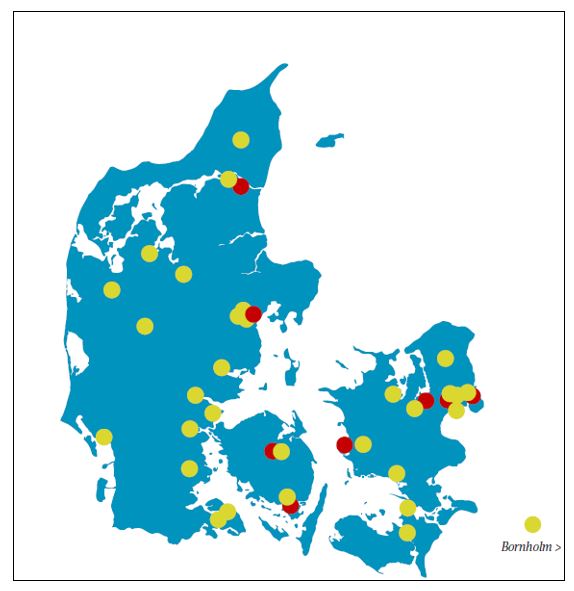Abstract
Background: The spectrum of disorders of the brain is large, covering hundreds of disorders that are listed in either the mental or neurological disorder chapters of the established international diagnostic classification systems. These disorders have a high prevalence as well as short- and long-term impairments and disabilities. Therefore they are an emotional, financial and social burden to the patients, their families and their social network. In a 2005 landmark study, we estimated for the first time the annual cost of 12 major groups of disorders of the brain in Europe and gave a conservative estimate of €386billion for the year 2004. This estimate was limited in scope and conservative due to the lack of sufficiently comprehensive epidemiological and/or economic data on several important diagnostic groups. We are now in a position to substantially improve and revise the 2004 estimates. In the present report we cover 19 major groups of disorders, 7 more than previously, of an increased range of age groups and more cost items. We therefore present much improved cost estimates. Our revised estimates also now include the new EU member states, and hence a population of 514million people.
Aims: To estimate the number of persons with defined disorders of the brain in Europe in 2010, the total cost per person related to each disease in terms of direct and indirect costs, and an estimate of the total cost per disorder and country.
Methods: The best available estimates of the prevalence and cost per person for 19 groups of disorders of the brain (covering well over 100 specific disorders) were identified via a systematic review of the published literature. Together with the twelve disorders included in 2004, the following range of mental and neurologic groups of disorders is covered: addictive disorders, affective disorders, anxiety disorders, brain tumor, childhood and adolescent disorders (developmental disorders), dementia, eating disorders, epilepsy, mental retardation, migraine, multiple sclerosis, neuromuscular disorders, Parkinson’s disease, personality disorders, psychotic disorders, sleep disorders, somatoform disorders, stroke, and traumatic brain injury. Epidemiologic panels were charged to complete the literature review for each disorder in order to estimate the 12-month prevalence, and health economic panels were charged to estimate best cost-estimates. A cost model was developed to combine the epidemiologic and economic data and estimate the total cost of each disorder in each of 30 European countries (EU27+Iceland, Norway and Switzerland). The cost model was populated with national statistics from Eurostat to adjust all costs to 2010 values, converting all local currencies to Euro, imputing costs for countries where no data were available, and aggregating country estimates to purchasing power parity adjusted estimates for the total cost of disorders of the brain in Europe 2010.
Results: The total cost of disorders of the brain was estimated at €798billion in 2010. Direct costs constitute the majority of costs (37% direct healthcare costs and 23% direct non-medical costs) whereas the remaining 40% were indirect costs associated with patients’ production losses. On average, the estimated cost per person with a disorder of the brain in Europe ranged between €285 for headache and €30,000 for neuromuscular disorders. The European per capita cost of disorders of the brain was €1550 on average but varied by country. The cost (in billion €PPP 2010) of the disorders of the brain included in this study was as follows: addiction: €65.7; anxiety disorders: €74.4; brain tumor: €5.2; child/adolescent disorders: €21.3; dementia: €105.2; eating disorders: €0.8; epilepsy: €13.8; headache: €43.5; mental retardation: €43.3; mood disorders: €113.4; multiple sclerosis: €14.6; neuromuscular disorders: €7.7; Parkinson’s disease: €13.9; personality disorders: €27.3; psychotic disorders: €93.9; sleep disorders: €35.4; somatoform disorder: €21.2; stroke: €64.1; traumatic brain injury: €33.0. It should be noted that the revised estimate of those disorders included in the previous 2004 report constituted €477billion, by and large confirming our previous study results after considering the inflation and population increase since 2004. Further, our results were consistent with administrative data on the health care expenditure in Europe, and comparable to previous studies on the cost of specific disorders in Europe. Our estimates were lower than comparable estimates from the US.
Discussion: This study was based on the best currently available data in Europe and our model enabled extrapolation to countries where no data could be found. Still, the scarcity of data is an important source of uncertainty in our estimates and may imply over- or underestimations in some disorders and countries. Even though this review included many disorders, diagnoses, age groups and cost items that were omitted in 2004, there are still remaining disorders that could not be included due to limitations in the available data. We therefore consider our estimate of the total cost of the disorders of the brain in Europe to be conservative. In terms of the health economic burden outlined in this report, disorders of the brain likely constitute the number one economic challenge for European health care, now and in the future. Data presented in this report should be considered by all stakeholder groups, including policy makers, industry and patient advocacy groups, to reconsider the current science, research and public health agenda and define a coordinated plan of action of various levels to address the associated challenges.
Recommendations: Political action is required in light of the present high cost of disorders of the brain. Funding of brain research must be increased; care for patients with brain disorders as well as teaching at medical schools and other health related educations must be quantitatively and qualitatively improved, including psychological treatments. The current move of the pharmaceutical industry away from brain related indications must be halted and reversed. Continued research into the cost of the many disorders not included in the present study is warranted. It is essential that not only the EU but also the national governments forcefully support these initiatives.
You can download the full article from the website of the European Brain Council:
http://europeanbraincouncil.org/projects/CDBE/2010/
Gustavsoon, A., et al., Cost of disorders of the brain in Europe 2010, Eur. Neuropsychopharmacol. (2011), doi: 10.1016/j.euroneuro.2011.08.008
Dissemination and use of the study by Jes Olesen
This huge study, sponsored by the European Brain Council (EBC), was published in European Neuropsychopharmacology 2011; 21: 715-780. It is an update of our similar study from 2005 but the new study is much more complete and accurate. Cost of disorders of the brain has increased by 100% and the new estimate is still conservative. The main result, a cost of 800 billion Euros per year in Europe equals the sum of the cost of cancer, heart disease and diabetes. Nobody had expected such high cost. These incredibly strong data demonstrate that increased emphasis on the care of patients with brain disorders and brain research as well as on the teaching in brain related disciplines is urgently required. The cost of disorders of the brain in Europe 2010 data are very important at the European level in supporting prominence for brain research in the Eighth Framework Program of the European Commission (FP8). However, they are equally important at the national level where they may influence national research council policies and national health care policies. They are even important at the very local level in each single hospital or each single faculty of medicine. Nowhere do the brain research and brain disorders receive an attention that equals their enormous costs. We sincerely hope that hundreds or thousands of neurologists will use the study plus a forthcoming shorter article. The latter shall bring the essentials of the study and will appear in European Journal of Neurology, January Issue 2012. We now want to dissimilate the pdf files of these two papers as widely as possible. They may be downloaded from the web site of the European Brain Council (www.europeanbraincouncil.org) and will also be sent electronically to all member organisations of the EBC including of course the EFNS. We request that these societies send on an introductory letter and the pdf files to each of the national societies and ask the national societies to send the pdf files to every single neurologist in their country. We hope that this will ascertain that our material is used at all the different levels from the individual clinic to the national level and to the European Union. If you have ideas and suggestions for the use of this material, please comment at this website so that others can benefit from your good ideas. A comment might for example be like this: “I used the cost data to demonstrate the high cost of stroke. This helped me to get a neurological stroke unit at my hospital. Signature.” I really hope that we can have a debate about the best possible use about these very strong data so that neurology can be strengthened as much as possible throughout Europe.
Yours sincerely,
Jes Olesen
Jes Olesen is Professor of Neurology at the University of Copenhagen,
Danish Headache Centre,
Department of Neurology at Glostrup Hospital,
Ndr. Ringvej 57, 2600 Glostrup, Denmark
Comment by Richard Frackowiak
Richard Frackowiak
The European Brain Council has now carried out two major surveys of the cost of brain diseases in Europe. The first appeared in 2005; the second, published this year, added data for the new EU member states, for more disease groups and more cost items. It also expanded the age range from 18 to 65, to the whole of life. The two estimates are very concordant. Table 4 from the 2011 paper summarises the main findings [printed here with permission], notably the costs per subject which were estimated at €3040 in 2005 and €2672 in 2011 (with costs adjusted for comparative price levels and nominal exchanges rates provided by the European Central Bank).
The implications of these findings are considerable. Historically, the pharmaceutical industry has invested large amounts of money in diseases such as stroke, headache and dementia, but its failure to produce blockbuster medicines has led it to withdraw from the complex domain of brain disease to more profitable pastures, and the public sector is not filling the gap. This is cause for very considerable concern in Europe, not only in terms of the human suffering that will be left in its wake, but also economically, given our ageing population. Another obvious message from the latest survey is that the R&D effort invested in individual brain diseases varies widely and with no obvious correlation to the burden those diseases represent.
The EBC has warned us before about the impending problem these data herald. It is dangerous to cry wolf. Nevertheless the replication of the results between 2005 and 2011, the latter having been produced with improved methodology, must raise the alarm. Public expenditure on research into, and management of, brain diseases, should increase as a proportion of the European budget, to reflect their burden. In parallel, the pharmaceutical industry needs to update its business models, interacting more closely and efficiently with academia and moving away from the blockbuster concept that now appears to have run its course. Academia, for its part, needs to consider ways of federating the fragmented data that it generates. A combined effort, based on new rules of engagement, could yet prove both profitable for industry and beneficial for European society as a whole.
Readers who are interested in learning more about these surveys are directed to the very rich distillation of data that constitutes the Cost of Disorders of the Brain in Europe 2010 study (European Neuropsychopharmacology (2011), Vol 21, p 718) and David Nutt’s excellent editorial in the same issue (p 715).
Richard Frackowiak (MD Prof) is Head of Department at the Department of Clinical Neurosciences, rue du Bugnon 46, 1011 Lausanne, Switzerland.








2 comments
The EFNS will certainly distribute this important paper to all its national delegates although I hope they will have seen it already. The figure of 800 billion euros for the European expenditure on neurological healthcare is so large that it is difficult to visualise. Do we have comparable figures for other diseases such as cardiac disease, cancer or joint disease for comparison? And do we know the relative spend on research into each of these disease groups at a European level? The disproportionately low expenditure on dementia and stroke research compared with cancer and coronary heart disease was highlighted by Luengo-Fernandez et al in the current European Journal of Neurology 2012 vol 19,1 p 149 – 155. Richard Hughes President EFNS
Dear Richard, as EFNS President you promise to alert national delegates, as it really is an important matter for all European neurologists to know, and act on this knowledge. I – as Co-Editor of Neuropenews – hope that perhaps some neurologists have obtained this information through this Forum. It would be grand if colleagues from different countries would let Neuropenews know about activities to promote neurology locally.